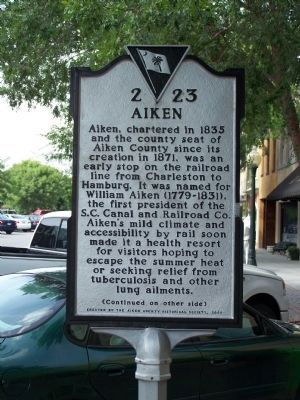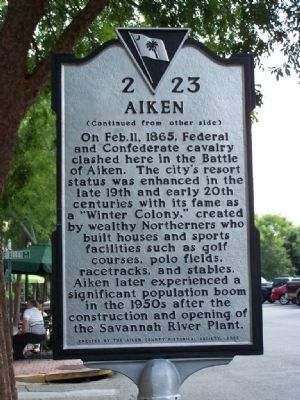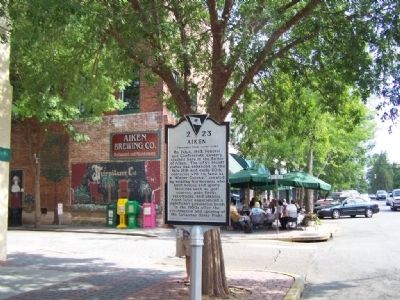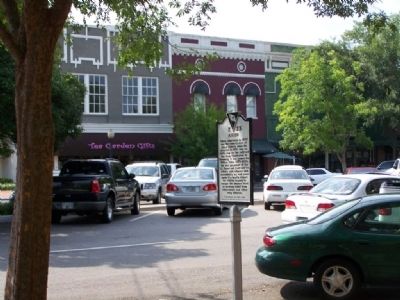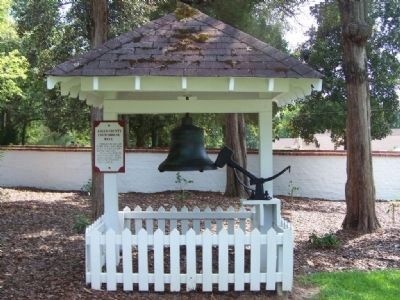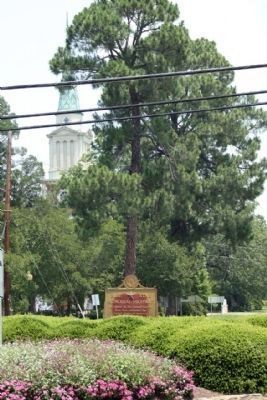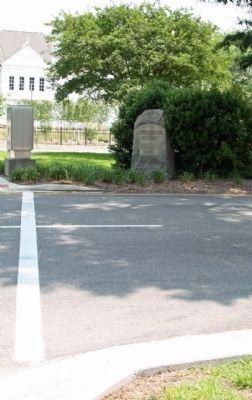Aiken in Aiken County, South Carolina — The American South (South Atlantic)
Aiken
On Feb. 11, 1865, Federal and Confederate cavalry clashed here in the Battle of Aiken. The city’s resort status was enhanced in the 19th and 20th centuries with its fame as a “Winter Colony,” created by wealthy Northerners who built houses and sports facilities such as golf courses, polo fields, racetracks, and stables. Aiken later experienced a significant population boom in the 1950s after the construction and opening of the Savannah River Plant.
Erected 2003 by Aiken County Historical Society. (Marker Number 2-23.)
Topics and series. This historical marker is listed in these topic lists: Industry & Commerce • Railroads & Streetcars • Settlements & Settlers • War, US Civil. In addition, it is included in the South Carolina, Aiken County Historical Society series list. A significant historical month for this entry is February 1862.
Location. 33° 33.625′ N, 81° 43.375′ W. Marker is in Aiken, South Carolina, in Aiken County. Marker is on Laurens Street SW near The Alley, on the right when traveling north. Touch for map. Marker is in this post office area: Aiken SC 29801, United States of America. Touch for directions.
Other nearby markers. At least 10 other markers are within walking distance of this marker. Aiken's Jewish Merchants (within shouting distance of this marker); Fallout Shelter (about 300 feet away, measured in a direct line); South Carolina Canal & Rail Road Company (about 300 feet away); The S.C. Railroad (about 300 feet away); 1953 Gas Explosion (about 300 feet away); Woodmen Of The World (about 300 feet away); Fred B. Cavanaugh (about 300 feet away); H. Odell Weeks (about 500 feet away); St. Thaddeus Church (about 600 feet away); William Aiken, Sr. (about 600 feet away). Touch for a list and map of all markers in Aiken.
Regarding Aiken. Three historical events generally shaped the physical development of Aiken: construction of the railroad line between Charleston, SC. and Hamburg, SC. in the 1830’s, the development of a winter resort industry based on equestrian sports in the 1880’s, and the establishment of the Savannah River Plant, a nuclear weapons facility, in the 1950’s. Today, Aiken reflects the influence of these events in the layout of its streets, the distribution of its neighborhoods, and the remarkable architecture spread throughout the City limits.
Leaders of the South Carolina Railroad and Canal Company wanted to develop real estate along the line to appeal to South Carolina residents wanting to escape the heat and disease associated with the summer months.
The company’s engineers designed the town of Aiken to have plenty of trees and open spaces which were believed to provide a healthier living environment.
A group of Charleston, South Carolina businessmen incorporated the South Carolina Rail Road and Canal Company (SCRRCC) in December 1827. William Aiken, one of South Carolina’s leading cotton merchants, served as president of the company between 1829 and 1831. SCRRCC wanted to develop a transportation link between Charleston and Augusta that would redirect trade that was going down the river to Savannah. Horatio Allen, an engineer from New York, selected the route from Charleston. Allen was nationally famous for supervising the first railroad in America, a short line for the Delaware and Hudson Canal Company. He was also the first person in the western hemisphere to drive a locomotive.7 The railroad line ran along the ridge between the Ashley and Cooper Rivers, crossed the Edisto River, and then turned west, following ridges towards Augusta and terminating in Hamburg, SC opposite Augusta.
Between 1830 and 1833, the SCRRCC constructed the 136-mile, single-track line from Charleston to Hamburg, creating the longest passenger railroad in the world at the time. It had three sections. The main section connected Charleston to Edisto Bridge (today known as Branchville), where the line branched into east and west lines. The eastern section went to Columbia. The western section passed through the towns of White Pond, Windsor, and Montmorenci, before reaching Hamburg. The western section was completed in the fall of 1833.
In the early years of the Winter Colony, visitors often rented houses or rooms in town, but over the following decades, families constructed their own homes, some establishing permanent residence in Aiken. In this period, families associated with the Winter Colony built exquisite mansions, often accompanied by extensive stable facilities and adorned with lavish, formal gardens. The Second World War, coming on the heels of the Great Depression, disrupted the seasonal arrival of winter visitors.
In 1952, the Atomic Energy Commission constructed the Savannah River Plant, an atomic energy facility on the Savannah River, at a site approximately fifteen miles from Aiken. Thousands of construction workers and plant personnel arrived in Aiken, first occupying hastily constructed temporary housing and then establishing new residential subdivisions pushing up against the historic neighborhoods of Aiken. Much of the plant’s related residential development occurred south of town, along Whiskey Road, the main artery connecting Aiken to the Savannah River Plant.
—(City of Aiken Historic Resources Survey Report, December 22, 2010)
Also see . . .
1. Historical events in Aiken. Per Wikipedia (Submitted on July 28, 2008, by Mike Stroud of Bluffton, South Carolina.)
2. City of Aiken Official Homepage. Official website of the city of Aiken. (Submitted on August 22, 2008, by Brian Scott of Anderson, South Carolina.)
3. Aiken, South Carolina. Aiken, South Carolina is a city in the United States state of South Carolina. (Submitted on August 22, 2008, by Brian Scott of Anderson, South Carolina.)
4. William Aiken. William Aiken (1779 – 1831), or William Aiken, Sr., was the founder and president of the pioneering South Carolina Canal and Rail Road Company. (Submitted on March 13, 2009, by Brian Scott of Anderson, South Carolina.)
5. South Carolina Canal and Rail Road Company. Chartered in 1827, the South Carolina Canal and Rail Road Company ran scheduled steam service over its 136-mile (219 km) line from Charleston, SC to Hamburg, SC beginning in 1833. (Submitted on March 13, 2009, by Brian Scott of Anderson, South Carolina.)
6. The Battle of Aiken. (Submitted on March 13, 2009, by Brian Scott of Anderson, South Carolina.)
7. The Battle of Aiken, SC
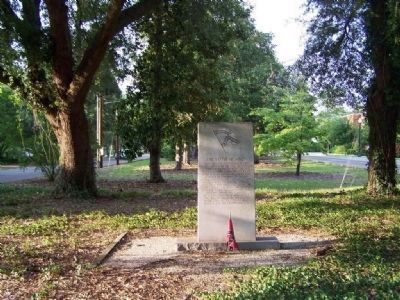
Photographed By Mike Stroud, July 25, 2008
5. Battle Of Aiken ,as mentioned on marker
Memorial reads :" Near this spot on February 11, 1865
was fought one of the final Confederate
victories of the War Between The States.
Federal Cavalry commanded by Major
General Hugh Judson Kirkpatrick were
attacked by Confederate Cavalry
commanded by Major General Joseph
Wheeler when the Federals entered
Aiken from the south east along the
South Carolina Railroad. The Federals
retreated to Montmorenci where their
infantry support was stationed.
Successful defense of Aiken by the
Confederates prevented the possible
destruction of the cities of Aiken,
Augusta and the Graniteville Mill."
8. Savannah River Site. Official website of the Savannah River Site. (Submitted on November 28, 2009, by Brian Scott of Anderson, South Carolina.)
9. Savannah River Site. The Savannah River Site (SRS) is a nuclear materials processing center in the United States in the state of South Carolina, located on land in Aiken Allendale and Barnwell Counties adjacent to the Savannah River, 25 miles southeast of Augusta, Georgia. (Submitted on November 28, 2009, by Brian Scott of Anderson, South Carolina.)
10. Hamburg, Aiken County, South Carolina. The dead town of Hamburg, South Carolina, was once a thriving upriver market located in Edgefield District (now Aiken County). It was founded by Henry Shultz in 1821, across the Savannah River from Augusta, Georgia, in direct competition with that city. (Submitted on November 28, 2009, by Brian Scott of Anderson, South Carolina.)
Additional commentary.
1. William Aiken and His Railroad
At the beginning of the nineteenth century, when South Carolina farmers began to grow cotton extensively, a constant stream of wagons carried the product over the old roads through the Aiken section
to Augusta on the Georgia side of the Savannah River. The consequent decrease in Charleston's trade was a prime factor in the establishment of Hamburg, to which the first railroad constructed for steam engines in the United States was begun from the port city in 1830. This was the Charleston-Hamburg line, later a branch of the Southern Railway. Two years were required for the completion of the tracks, and meanwhile William Aiken, father of Governor Aiken, had become president of the company. When a town site was laid out in 1834 near the western terminus of the road, it was named for him. The Nation's first passenger train and the first train carrying United States mail passed through Aiken. (Source: South Carolina: A Guide to the Palmetto State by Federal Writers Project, pg 160.)
— Submitted November 28, 2009, by Brian Scott of Anderson, South Carolina.
2. The Aiken Family
To record however briefly the names and achievements of the Aiken family of South Carolina is to call a long roll of some of those who have been most eminent and useful within the borders of the state since the foundation of the Republic. Their patriotic qualities have made soldiers almost without number, and always the name has stood for the finest virtues and flower of citizenship and business and
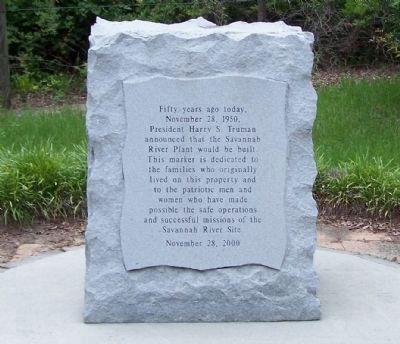
Photographed By Mike Stroud, 2008
7. As mentioned, Savannah River Plant Site
Memorial Reads : "Fifty Years ago today,
November 28, 1950,
President Harry S.Truman
announced that the Savannah
River Plant would be built.
This marker is dedicated to
families who originally
lived on this property and
to the patriotic men and
woman who have made
possible the safe operations
and successful missions of the
Savannah River Site
November 28, 2000"
November 28, 2000"
The Charleston merchant and business man upon learning of the death of his father in Ireland sent money to his mother to bring her and the younger children to America. They reached Charleston in !799, and were soon located
in the Little River section of Fairfield District. To that community two of the older sons, Hugh and John, had already proceeded.
The youngest of the eight children of James and Elizabeth Aiken of County Antrim was David Aiken, who on coming to South Carolina remained with his brother William as a clerk at Charleston during the winter and in the summer went to the home of the family in Fairfield County to work on the farm. In 1805 with the assistance of his brother William he opened a small store at Winnsboro. He had as much commercial ability as his brother, was prospered and acquired large landed possessions and for many years was one of the wealthiest residents of Fairfield County. He married in 1812 Nancy Kerr, also a native of County Antrim, Ireland, who had come to the United States in her youth and after the death of her parents was reared by her uncle Maj. Joseph Kerr, a resident of York District, South Carolina, and a veteran of the War of 1812. David and Nancy Aiken spent their married lives in Winnsboro and their remains are now at rest in the old cemetery of Scion Presbyterian Church in that town. They were survived by seven sons and two daughters, then past their majority. The following paragraphs are a brief record of these seven sons and two daughters: James Reid graduated from South Carolina College in 1832, was for many years his father's partner as a
merchant at Winnsboro. He was a soldier in the Seminole Indian war of 1836, and for two terms represented Fairfield District in the Legislature.
Elizabeth Rachel, the oldest daughter, became the wife of Dr. Osmund M. Woodward of Fairfield County.
Joseph Daniel, the third child, graduated from South Carolina College in 1841, became a Charleston lawyer, served in the Confederate army and after the war was a cotton factor and agent for a line of steamers at Charleston, where he died in 1884 when nearly sixty-seven years of age.
The other daughter of David and Nancy Aiken was Caroline Margaret, who never married.
Hugh Kerr Aiken had a brilliant military record, rising to the rank of colonel of the Sixth South Carolina Cavalry, and was in command of that regiment when killed in action near Mount Elon Church, Darlington County, South Carolina, 1865.
Dr. William Edward Aiken, the sixth among the children, was graduated from South Carolina College in 1846, attended medical lectures in Charleston and Baltimore, finishing his medical course in Paris. He was practicing at Winnsboro when the war between the states broke out and at the urgent request of the community and local authorities remained to care for the sick instead of entering the army. He continued practice at Winnsboro with great usefulness and honor until his death in 1900.
David
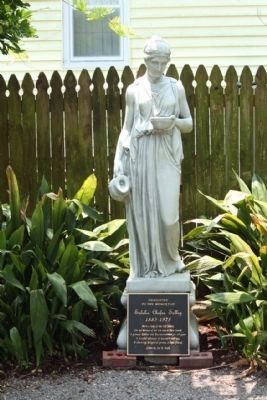
Photographed By Mike Stroud, 2011
10. Aiken's Memorial to Eulalie Chafee Salley
To the Memory of
Eulalie Chafee Salley
1883-1975
Born a lady of the old South,
She led women of her era into a New South.
A pioneer Realtor and Businesswoman for 60 years
A forceful advocate of woman's suffrage,
A charming, delightful person, a loyal friend.
Isaac Means Aiken graduated from South Carolina College in 1851, became a merchant at Winnsboro, and from there moved to Georgia where he engaged in the lumber business, and volunteered with the Forty-Seventh Georgia Regiment in the war, being elected captain of Company H. Following the war he returned to the lumber business at Pensacola. Florida, where he died in 1907.
The seventh son and youngest child of David and Nancy (Kerr) Aiken was Augustus Milton Aiken, who was born at Winnsboro January 10, 1834. He was living at Charleston when the war broke out and was engaged in the cotton business there. He at once volunteered, becoming a member of Company C of the Seventh South Carolina Infantry. In 1864 he was made Ordnance Officer and assigned to Butler's Brigade of South Carolina Cavalry, and had the pleasure and distinction of being on the personal staff of that eminent South Carolinian, Maj.-Gen. M.C. Butler. With the close of the war he engaged in farming at "Stoney Point" and "Coronaca," and in 1867 removed to "Sunnyside," Greenwood, the home of his second wife. He had married in 1860 Emma Eliza Smith, who died July 30, 1864, at Winnsboro, the mother of no children. On May 23, 1866, he married Mary Ann Chapman Gillam. Mary Ann Chapman Gillam was born January 27, 1845, and died June 2, 1877. Her name introduces another notable family record into this brief chronicle. She was a daughter of Robert Charles and Mary Sophia (Glenn) Gillam, whose children were named Mary Ann Chapman, Sarah Sophia, Jessie Louisa and Carrie Cornelia. Robert Charles Gillam was born August 13, 1820, and died September 18, 1897. His parents were Gen. James and Sarah (Satterwhite) Gillam. Gen. James Gillam was born in 1791 and died in 1878 at Greenwood, where he had lived for many years. He was a first cousin and intimate friend of John C. Calhoun. Gen. James Gillam's parents were Robert and Elizabeth (Caldwell) Gillam, and both Robert and his father Maj. Robert Gillam were soldiers of the Revolutionary war. Maj. Robert Gillam was a very early settler in Newberry District. Elizabeth Caldwell, wife of Robert Gillam, Jr., was a daughter of William and Rebecca Caldwell who came from Ireland, first settling in Pennsylvania, whence they removed to Charlotte County, Virginia, where William Caldwell died. His widow with her ten children in 1770 came to Newberry District, South Carolina, where she died in 1807 at the extreme age of ninety-nine. Her daughter was Martha Caldwell who became the wife of Patrick Calhoun and the mother of South Carolina's most eminent historic figure, John C. Calhoun.
As noted above the mother of Mary Ann Chapman Gillam was Mary Sophia Glenn. Her parents were Dr. George W. and Mary Ann (Chapman) Glenn and her grandfather Col. David Glenn came from Ireland about 1774, settling in Newberry District, and served as adjutant in Col. James Giles' regiment during the War of the Revolution. He also represented Newberry District in the First Carolina Legislature. Dr. George W. Glenn married for his first wife Hannah Thompson Lawson. When he married Mary Ann Chapman she was the widow of Dr. John Hooker, a native of Connecticut, a graduate of Yale College, and long distinguished for his success as a lawyer at Columbia, South Carolina. Mary Ann Chapman was a daughter of Gershom and Mary (Carew) Chapman, and a sister of Rebecca Chapman who married Dr. John Logan. Doctor Logan practiced medicine at Greenwood, South Carolina, and his son Dr. John Henry Logan is recalled as author of "History of Upper South Carolina."
Augustus Milton Aiken died suddenly of angina pectoris August 9, 1906, at Charlotte, North Carolina, and was laid to rest beside his wife at Greenwood, South Carolina. He and his wife were active Presbyterians and he a Master Mason. By his marriage to Mary Ann Chapman Gillam he had three children: Hugh Kerr, James Gillam, Jessie Glenn Aiken, all of whom after the death of their mother, were reared by their aunt Mrs. Eliza Woodward.
This brings the record of the Aiken family to Hugh Kerr Aiken of Laurens, long prominent as a physician, banker and citizen of that community. He was born at Greenwood October 3, 1867, and attended public school in his native village and also at Washington, District of Columbia, while residing with his uncle D. Wyatt Aiken, then a member of Congress. He also pursued an elective two years' course in South Carolina College, spent one year in the University of Maryland at Baltimore, and in 1890 received his M. D. degree from the Medical College of South Carolina at Charleston, with the first honors of his class. His student record gave him an appointment as intern in the City Hospital, where he remained one year. Doctor Aiken began practice at Laurens in 1891, and gave practically his undivided time to his professional interests for ten years. In the meantime and since he has been interested in the drug business, and was associated with one of the eminent physicians of Laurens the late Dr. Thomas McCoy until his death.
Doctor Aiken was a director of the Laurens National Bank when by reason of the sudden death of the cashier an emergency arose and at the urgent request of the other directors Doctor Aiken assumed the duties of cashier. He took the office as a temporary responsibility, but subsequently was regularly chosen cashier, and has since followed banking entirely, giving up his professional practice altogether. He served as cashier from 1902 to 1918, and since the latter year has been president of this old and substantial institution. He and his wife are active members of the Presbyterian Church and for several years he was a deacon and is now one of the ruling elders.
Doctor Aiken married March 30, 1893, Mary Chalmers Thames of Charleston. They have two sons, Hugh Kerr, Jr., a chemist at Niagara Falls, New York, and a graduate of Davidson College, North Carolina, where his younger brother Robert Chalmers, is now a student. (Source: History of South Carolina, Volume 3 by Yates Snowden (1920), pgs 197-199.)
— Submitted November 28, 2009, by Brian Scott of Anderson, South Carolina.
Credits. This page was last revised on June 16, 2016. It was originally submitted on July 28, 2008, by Mike Stroud of Bluffton, South Carolina. This page has been viewed 5,276 times since then and 89 times this year. Photos: 1, 2, 3, 4. submitted on July 28, 2008, by Mike Stroud of Bluffton, South Carolina. 5, 6, 7. submitted on November 28, 2009, by Mike Stroud of Bluffton, South Carolina. 8, 9, 10. submitted on June 6, 2011, by Mike Stroud of Bluffton, South Carolina. • Craig Swain was the editor who published this page.
